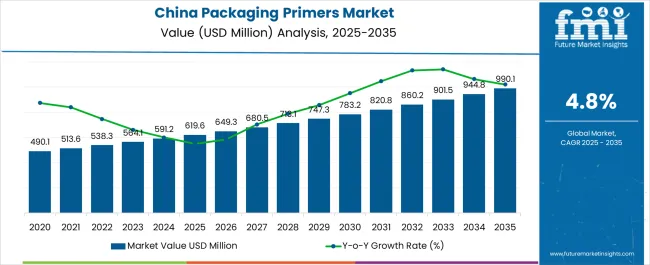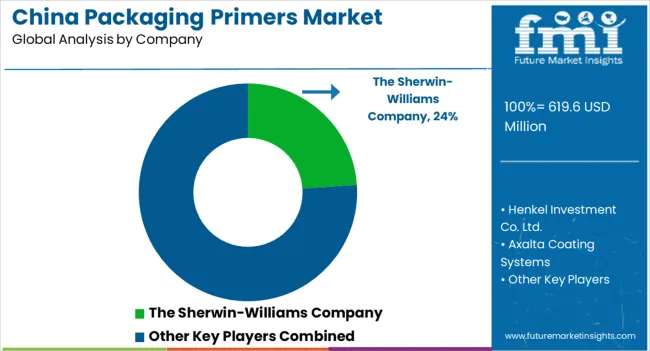The China Packaging Primers Market is estimated to be valued at USD 619.6 million in 2025 and is projected to reach USD 990.1 million by 2035, registering a compound annual growth rate (CAGR) of 4.8% over the forecast period.

| Metric | Value |
|---|---|
| China Packaging Primers Market Estimated Value in (2025 E) | USD 619.6 million |
| China Packaging Primers Market Forecast Value in (2035 F) | USD 990.1 million |
| Forecast CAGR (2025 to 2035) | 4.8% |
The China packaging primers market is expanding steadily, driven by the rising demand for sustainable packaging, rapid growth of the e commerce sector, and increasing investment in advanced coating technologies. Packaging primers are being adopted to enhance printability, adhesion, and barrier properties of flexible and rigid packaging substrates.
Water based formulations are gaining preference due to stricter environmental regulations and corporate commitments toward reducing volatile organic compound emissions. Growing adoption of packaged food, beverages, and personal care products in urban regions is also supporting demand for advanced primer applications.
Technological improvements in water based and solvent free solutions, combined with government support for green chemistry initiatives, are creating favorable growth opportunities. The market outlook remains promising as brand owners and converters in China focus on sustainability, performance, and innovation in packaging solutions.
The water based coating segment is projected to hold 54.20% of the total market revenue by 2025 within the primer type category, making it the leading segment. This dominance is attributed to increasing regulatory emphasis on environmentally friendly formulations, reduced emissions, and improved worker safety.
Water based coatings have also been favored for their compatibility with a wide range of packaging substrates and their ability to enhance adhesion, print quality, and barrier performance.
As the packaging industry in China shifts toward greener solutions, converters and manufacturers are increasingly adopting water based primers, reinforcing the segment’s leadership position.
The film makers segment is anticipated to contribute 47.60% of overall revenue by 2025 within the application category, establishing it as the largest segment. This growth is being fueled by the increasing consumption of flexible packaging films in food, beverage, and consumer goods sectors.
Packaging primers used by film makers improve surface energy, enable high quality printing, and ensure strong adhesion for laminates and coatings. The rise of e commerce, along with growing demand for lightweight, durable, and customizable packaging formats, has further supported adoption in this segment.
With expanding production capacities and rising export demand, film makers continue to dominate the application landscape in the China packaging primers market.
According to Future Market Insights (FMI), the China market for packaging primers registered a sluggish 3.4% CAGR between 2020 and 2025. The market settled at a USD 619.6 million in 2025. Compared to the acceleration observed by FMI from 2020 to 2025, the coming years promise to be brighter.
Packaging primers can be solvent-based, water-based, or wax and poly coatings that can easily enhance the efficiency of printing on various surface. They can provide adequate friction for better slip control, moisture resistance, anti-blocking, and release. Plastic coatings and solvent-based primers provide print finishes that are high in quality and offer protection for numerous applications.
A significant factor driving the China market is the country’s burgeoning e-commerce sector. Flexible packaging recorded the strongest acceleration despite the fact that the packaging industry in China has a large base. The regular introduction of new flexible packaging products with additional benefits such as lightweight, sustainability, and convenience for use is facilitating market expansion.
The only factor hindering the market’s growth is the country’s strict governmental laws and certification policies. Packaging companies need to comply with these rules, which increases their operational difficulties as they need to meet the set standards and regulations.
Manufacturers of packaging primer solutions serve nearly every application in cosmetic & personal care, food & beverage, and pharmaceutical industries. This is set to add value for brand owners as well as providing operational advantages.
Rising Adoption of Printing Tech in China Packaging Market to Drive Packaging Primers Demand in the Country
In the last few years, digital printing has expanded the scope for brands to engage with their target audiences. Packaging primers offer benefits such as increased manufacturing productivity. They are effective at rapid ink drying and adhesion , and also at enhancing the end-product quality.
Packaging primers enable the adhesion between substrates and inks in inkjet printing which forms a strong bond between these two. This incorporation of printing technologies in the Chinese packaging industry is projected to offer an ample amount of opportunities to primers manufacturers to maximize their sales and financial profitability.
Reduction of VOC Emissions to Drive Adoption of Water-based Coating Segment and Spur Packaging Primers Sales in China
In the case of water-based coatings, water acts as a vehicle to transport the resin and additives onto the element to be treated. Water-based diluents lower the emission of solvents to nearly zero and only harmless water is released into the environment. Based on these factors, water-based coatings are recognized as water-soluble and environmental friendly.
The water-based coatings process also reduces the emission of VOCs (Volatile Organic Compounds) into the atmosphere by a significant extent compared to solvent-based coatings. Also, water-based coatings are non-flammable, odorless, and have extremely low toxicity levels.
As water-based coatings have no solvents or fewer solvents, they are an ideal way to reduce businesses’ VOC (Volatile Organic Compounds) output. For manufacturing companies, this is a means of spending less on environmental compliance advising or keep them from playing significant fines for crossing the VOC quotas. Though solvent-based coatings represent dominance in the packaging primers market, water-based coatings are likely to gain significant attention over the coming years as well.
Ability of Solvent-Based Coating to Cure Efficiently to Make it Dominant Segment in China Market for Packaging Primers
Based on primer type, FMI expects the solvent-based coating segment to generate significant demand in the coming years. Solvent-based film coating consists of a liquid layer made from a variety of organic compounds. It provides protection and is generally regarded as better than water-based coating in terms of resilience and preventing corrosion.
There are several regions within China where the environment tends to stay humid for multiple months every year. In such environments, curing water-based coating tends to be time consuming. In an industry where productivity is the priority, this leads to efficiency issues.
However, solvent-based coating segments are not held back by this issue and they can cure efficiently even in the most humid environments. This is likely to make solvent-based coating the number one choice in the years ahead, especially across humid regions in China.
Despite the benefits of solvent-based coating over the limitations of water-based coating, the fact is that the former is more damaging for the environment. If the Chinese government introduces strict laws to prevent environmental damage, this segment may find itself threatened.

The leading players operating in the China market for packaging primers are focusing on expanding their resources and manufacturing capabilities through acquisitions and partnership strategies. Also, the players are offering more innovative products to address the growing demand for more utility.
For instance:
| Attribute | Details |
|---|---|
| Estimated Market Size (2025) | USD 619.6 million |
| Projected Market Size (2035) | USD 990.1 million |
| Anticipated Growth Rate (2025 to 2035) | 4.8% |
| Forecast Period | 2025 to 2035 |
| Historical Data Available for | 2020 to 2025 |
| Market Analysis | USD million for Value |
| Key Segments Covered | Primer Type & Application |
| Key Companies Profiled | The Sherwin-Williams Company; Henkel Investment Co. Ltd.; Axalta Coating Systems; BASF SE; PPG Industries Inc.; The Lubrizol Corporation; Coim Group; DIC Group; Wacker Chemie AG; Stahl Holdings B.V.; Michel Man, Inc. 8; Paramelt B.V.; Empowera TechOrganics; Mica Corporation; UFlex Ltd.; Reltek LLC.; Union Specialties Inc.; Levaco Chemical GmbH; LEAUNA-harze GmbH; AquaBased Technologies; Actega; Interplast Chemicals; Aqua Coat; Siegwork Druckfarben AG & Co. KGaA |
| Report Coverage | Market Forecast, Company Share Analysis, Competition Intelligence, Drivers, Restraints, Opportunities, and Threats Analysis, Market Dynamics and Challenges, and Strategic Growth Initiatives |
The global china packaging primers market is estimated to be valued at USD 619.6 million in 2025.
The market size for the china packaging primers market is projected to reach USD 990.1 million by 2035.
The china packaging primers market is expected to grow at a 4.8% CAGR between 2025 and 2035.
The key product types in china packaging primers market are water-based coating, solvent-based coating, wax coating and poly coating.
In terms of application, film makers segment to command 47.6% share in the china packaging primers market in 2025.






Full Research Suite comprises of:
Market outlook & trends analysis
Interviews & case studies
Strategic recommendations
Vendor profiles & capabilities analysis
5-year forecasts
8 regions and 60+ country-level data splits
Market segment data splits
12 months of continuous data updates
DELIVERED AS:
PDF EXCEL ONLINE
China Autonomous Crane Market Size and Share Forecast Outlook 2025 to 2035
China Elevator Ropes Market Size and Share Forecast Outlook 2025 to 2035
China Spinal Fusion Market Analysis - Trends, Demand & Forecast 2025 to 2035
China Outbound Meetings, Incentives, Conferences, Exhibitions (MICE) Tourism to Europe Market Size and Share Forecast Outlook 2025 to 2035
China Casino Tourism Market Analysis – Size, Growth, & Forecast Outlook 2025 to 2035
China Clay Market Size, Growth, and Forecast for 2025-2035
China Industrial Hoses Market - Size, Share, and Forecast 2025 to 2035
China Outbound MICE Tourism to US Market 2025 to 2035
China Destination Wedding Market Insights – Growth & Forecast 2025-2035
China Centrifugal Pumps Market Trends – Size, Demand & Forecast 2025-2035
China Power Tool Market Analysis – Size, Share & Forecast 2025-2035
China Educational Tourism Market Insights – Trends, Growth & Forecast 2025-2035
China Outbound Travel Market Report – Trends, Size & Forecast 2025-2035
China Sports Tourism Market Analysis – Growth, Demand & Forecast 2025-2035
China Extended Stay Hotel Market Trends – Growth, Demand & Forecast 2025-2035
China Hostel Market Analysis – Size, Share & Industry Forecast 2025-2035
China Medical Tourism Industry Analysis from 2025 to 2035
China Culinary Tourism Market Insights - Growth & Forecast 2025 to 2035
China Protein A Resins Market Report – Growth, Trends & Industry Outlook 2025-2035
China Pharmaceutical Intermediate Market Insights – Trends, Demand & Growth 2025-2035

Thank you!
You will receive an email from our Business Development Manager. Please be sure to check your SPAM/JUNK folder too.
Chat With
MaRIA